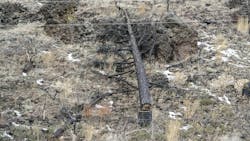As wildfires across the U.S. become more destructive and frequent, utility infrastructure is under increasing scrutiny. In many recent cases, aging poles and power lines have been identified as ignition sources—sparking calls for faster, more effective strategies to reduce risk and protect communities. While long-term plans to underground overhead lines are underway in several states, the timeline and cost of these projects have highlighted the need for complementary, near-term solutions.
Utility Infrastructure and the Escalating Wildfire Threat
In February 2024, the Smokehouse Creek Fire in Texas burned more than one million acres, becoming the largest wildfire in state history. Authorities determined it began when a decayed wooden utility pole—previously reported as compromised—failed, causing power lines to spark the fire. It wasn’t the first time aging infrastructure played a role in such devastation.
In California, the 2018 Camp Fire—the deadliest in state history—was traced to a worn metal hook on a transmission tower. Also in Northern California and just a few years later, a utility pole fuse failure contributed to the Dixie Fire, which burned 963,309 acres. More recently, equipment operated by Southern California Edison was identified as the likely cause of the Hurst Fire in Los Angeles. One of the many fires that ravaged the area in January of this year.
Each of these incidents underscores the risks posed by outdated equipment—particularly in high fire-risk areas where heat, wind, and dry conditions can turn a spark into a catastrophe. The High Cost and Long
Timeline of Undergrounding
In response to these threats, utilities and regulators have increasingly looked to undergrounding power lines as a fire mitigation strategy. In California alone, PG&E, Southern California Edison (SCE), and San Diego Gas & Electric (SDG&E) estimate that burying the state’s 200,000 miles of overhead lines could cost up to $6 million per mile. For many regions, these efforts are expected to take years or even decades to complete.
While undergrounding can be highly effective, the current pace of implementation means many vulnerable areas will remain exposed for the foreseeable future. In this context, utilities are exploring grid-hardening alternatives that can be deployed quickly and at scale.
Grid Hardening as a Complementary Strategy
Grid hardening refers to measures that strengthen existing infrastructure against hazards like wildfire, wind, and extreme temperatures. These can include replacing older poles with fire-resistant materials, adding protective barriers, and enhancing vegetation management. One emerging approach is the use of advanced pole wraps—protective coverings that insulate wooden poles from fire exposure.
Among the companies developing this technology is GridWrap, a U.S.-based firm offering wildfire-resistant pole protection systems. GridWrap’s grid hardening solutions, including BULLWRAP and DEMIRWRAP, are engineered to provide both fire protection and structural reinforcement for wood utility poles—reducing the risk of ignition during wildfires and extending pole service life by up to 30 years.
To evaluate the effectiveness of its system, GridWrap partnered with the Western Fire Center Inc. to conduct fire testing aligned with a proposed ASTM standard for utility poles exposed to wildfire conditions. The testing protocol simulated real-world wildfire behavior, including radiative heat, convective flames, and wind exposure.
The method involved wrapping standard wooden utility poles in GridWrap’s BULLWRAP and exposing them to a 50 kW/m² radiant heat flux followed by a 40 kW convective flame source and wind speeds of 2.0 m/s. The test aimed to measure char depth and assess pole degradation.
Post-exposure analysis showed no observable charring on the wrapped poles, with minimal surface changes even after intense heat and wind. These findings suggest that GridWrap’s solution can meaningfully reduce fire vulnerability in wooden utility poles.
Cost and Deployment Considerations
Compared to full-scale undergrounding, grid-hardening solutions like GridWrap’s offer a significantly lower cost per mile and can be deployed rapidly with no service interruptions. Installation can be performed by existing utility field crews, making it easier to scale across large service territories.
With cost savings of up to 90% compared to pole replacement, and the ability to extend pole life by decades, such solutions offer a compelling option for utilities working to reduce fire risk in high-exposure areas.
Looking Ahead
As the utility sector contends with climate-driven challenges, grid hardening is gaining traction as an essential part of wildfire risk management. While undergrounding remains a long-term goal for many regions, solutions like GridWrap’s grid hardening solutions—tested, scalable, and immediately deployable—are increasingly being recognized as critical tools for improving resilience in the near term. The events of recent years have shown the high stakes of waiting. Incorporating a diverse set of fire mitigation strategies, including protective treatments for existing infrastructure, may offer a more balanced and timely response to the growing risk of utility-sparked wildfires.
About the Author
Davoud Zamani
Davoud Zamani is GridWrap CEO and co-founder.
